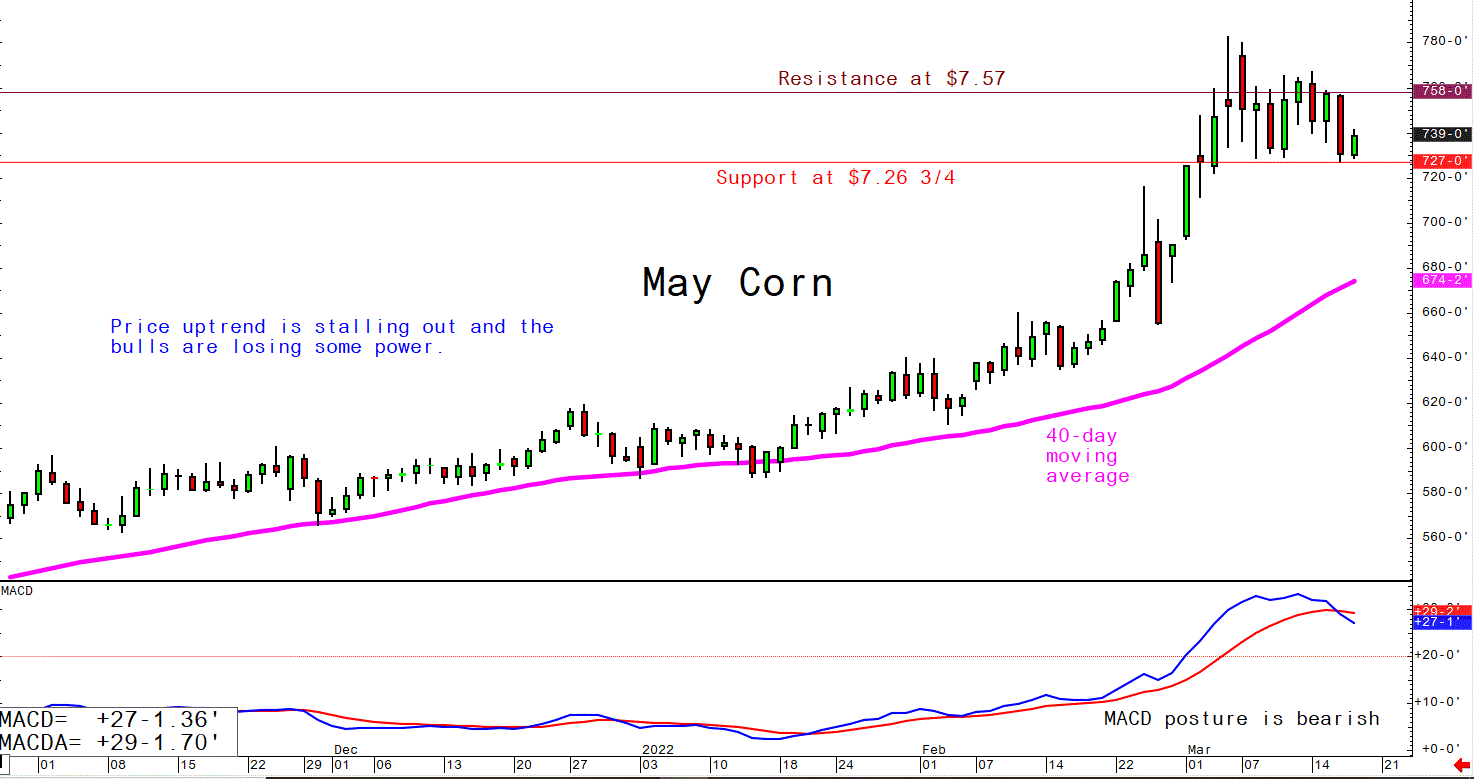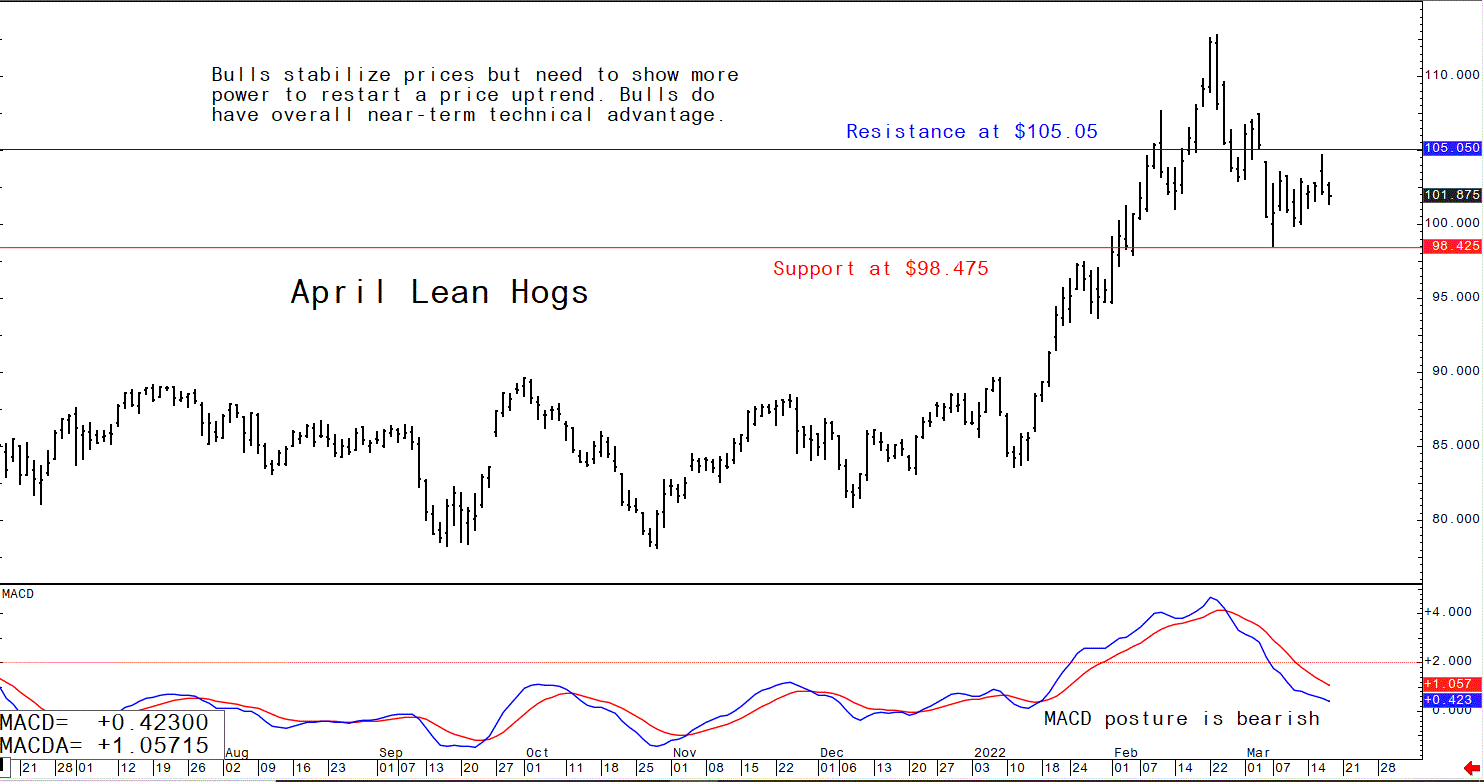



Pig outlook: Bulls stabilize prices, faster US line speeds
The pig traders’ perspective: The lean hog futures bulls have this week worked prices well up from the March low, which has given the bulls some technical strength. The decline in the CME lean hog index is weighing on April hog futures, however. Pork cutout value has continued its recent recovery, to limit selling pressure. Meantime, summer lean hog futures contracts are supported by prospects for a seasonal surge to annual highs, as well as the idea that the 4% annual decline in hog numbers will push futures prices well above the year-ago peak at $122.68.
Latest US Department of Agriculture (USDA) reports, and other news
US pork export sales up in latest week
USDA Thursday reported US pork net sales of 38,300 MT for 2022 were up 51 percent from the previous week and 36 percent from the prior 4- week average. Increases were primarily for Mexico (21,700 MT, including decreases of 200 MT), Japan (6,100 MT, including decreases of 100 MT), Australia (2,700 MT, including decreases of 100 MT), Honduras (1,500 MT), and South Korea (1,400 MT, including decreases of 700 MT). Exports of 26,000 MT were down 9 percent from the previous week and 13 percent from the prior 4-week average. The destinations were primarily to Mexico (10,900 MT), Japan (3,900 MT), China (3,800 MT), South Korea (2,100 MT), and Canada (1,400 MT).
USDA approves faster line speeds at three US pork plants
USDA approved faster line speeds at Clemens Food Group in Hatfield, Pennsylvania; Quality Pork Processors in Austin, Minnesota; and Wholestone Farms Cooperative in Fremont, Nebraska, as part of a pilot program. Plants approved for the trial program can operate at faster speeds for up to a year and are supposed to collect data on how line speeds affect workers. Nine plants were eligible to apply for the trial program because they were previously able to accelerate processing under the Trump-era rule.
Highlights of USDA monthly livestock
Pork/Hogs: The 2022 pork production forecast is reduced by 65 million pounds from last month on lower-than-expected February slaughter numbers, the likelihood of higher average carcass weights in the second half of the year, and evidence of elevated disease risks, also late in the year. Forecasts for U.S. pork exports in the first and second quarters of 2022 are reduced on weaker demand prospects in major importing regions. Total 2022 exports are expected to be 6.73 billion pounds, 4.3 percent below last year.
Summary Beef/Cattle: The forecast for 2022 commercial beef production was raised by 195 million pounds from last month to 27.570 billion pounds on higher expected non-fed and fed cattle slaughter. The fed cattle price was raised for 2022, while the feeder cattle price was lowered. January’s beef imports totaled 352 million pounds, up almost 57 percent from a year ago. The 2022 annual forecast for beef imports was increased by 50 million pounds from last month to 3.42 billion pounds. January’s beef exports totaled 288 million pounds, up 17 percent over the previous year. The beef export forecast for 2022 was raised by 30 million pounds to 3.30 billion pounds.
FAO warns of escalation in food prices
The U.N. Food and Agriculture Organization (FAO) is warning the situation in Russia and Ukraine could lead to an escalation in food prices, citing “disruptions to agricultural activities of these two major exporters of staple commodities could seriously escalate food insecurity globally, when international food and input prices are already high and volatile. Global prices of food and feed could rise by 8% to 20% as a result of the conflict in Ukraine, FAO warned.
The conflict could also constrain agricultural production and purchasing power in Ukraine, leading to increased food insecurity locally. “Livestock and poultry rearing as well as production of high value crops, such as fruits and vegetables, could also be constrained in Ukraine,” the FAO said. However, the FAO said they do not see any “major impacts” on agricultural production in the Russian Federation.
USDA seeks feedback on information it needs for hog producer payments
USDA is seeking comment on the information it needs to collect under the Spot Market Hog Pandemic Program (SMHPP), an aid effort under the Covid aid package. USDA is seeking comment on the information they need to collect to determine whether a producer is eligible for SMHPP and to calculate a payment. Comments are due April 11, according to a notice in the Federal Register today (March 11). SMHPP will use $50 million to compensate eligible hog producers sold through a negotiated sale from April 16-September 1, 2020. USDA announced the effort March 24, 2021, but no payments have been made. USDA estimates there will be 23,113 respondents relative to the information request.
USDA: quarterly hog prices raised on strong pork demand and reduced slaughter
USDA reports quarterly hog prices are raised as strong pork demand drives hog prices higher for reduced animal numbers. Prices for first-quarter 51-52 percent live equivalent hogs are expected to average $66 per cwt, about 19 percent higher than a year ago. Second- and third-quarter prices are raised to $78 and $75 per cwt, respectively. Both second- and third-quarter prices remain below a year ago—by 3.6 percent and by 2 percent, respectively—when wholesale pork prices were record-high.
Fourth-quarter prices are expected to be $65 per cwt, more than 15 percent above a year ago. For 2022, quarterly forecasts for live equivalent prices of 51-52 percent lean hogs average $71 per cwt, 5.5 percent higher than in 2021. Revised quarterly pork production forecasts for 2022 sum to 27.3 billion pounds, about 64 million pounds lower than last month and 1.3 percent lower than production in 2021.
Pork production in the first quarter is expected to be about 6.9 billion pounds, more than 5 percent lower than a year ago. The second-quarter forecast, at about 6.6 billion pounds, is down almost 2 percent from a year earlier, unchanged from last month. Second-half pork production is lowered marginally—by 55 million pounds—to account for elevated first-quarter disease risk indicated by data from the Swine Health Information Center,7 as well as for lower average dressed weights that may result from incentives for producers to market hogs in as timely a fashion as possible.
Third-quarter pork production is expected to be almost 6.7 billion pounds, 2.4 percent higher than a year ago. Fourth-quarter production is forecast at 7.2 billion pounds, fractionally lower than the same period last year. USDA will release the Quarterly Hogs and Pigs report on March 30. The report will contain new information relating to March 1 inventories, and December-February farrowings, litter rates, and pig crops. The report will also publish producers’ second farrowing intentions for the March-May quarter and first producer intentions for the summer June-August 2022 quarter.
The next week’s likely high-low price trading ranges:
April lean hog futures--$100.00 to $107.45, and with a sideways-higher bias
May soybean meal futures--$460.00 to $500.00, and with a sideways-higher bias
May corn futures--$7.00 to $7.82 3/4, and a sideways bias
Latest analytical daily charts lean hog, soybean meal and corn futures












